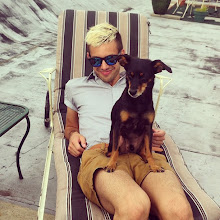
Around the end of this past semester a giant inflatable torus was brought to life on the Kent State campus, a product of the Operative Detailing seminar led by Jason Turnidge. Since I was in Italy, I couldn't be there at that time, however much to my delight, the big plastic fun house was re-inflated this summer here in Cleveland within the courtyard of the Sculpture Center.


Named treehugger: giant torus, the courtyard in Cleveland was not the original site for the project, and even though providing a tree (as did the campus site...hence the pun), a few permanent sculptures required that the structure be roped and suspended over them, re-adapting the torus to the new site.
But after releasing this project to the greater Cleveland area it begs the question, “What are the intentions, if any?” Was the project decidedly satirical, or maybe just purposefully offensive. Is "treehugger" a play on words or is it simplistically and innocently literal? Was the selection of the torus shape an exploitation of design process or explotation of exploitation? By no stretch of the imagination the goal was to provoke not just the viewer but architecture at large; which I can definitely get into.
From the artist's statement: “Doing more with less” -- a Buckminster Fuller ideology in a situation when there is no “more”. No fabrication lab, no CNC mill, no … – only an idea to provide a back drop for an event made feasible through the use of a diagram, a plotter, sharpies, 4 mil vapor barrier, tape, a leaf blower, and time. 36 unique two-dimensional surfaces are hand cut in 4 mil vapor barrier, individually taped into continuous loops, and joined edge to edge on 35 seams accounting for 10,357 linear feet of packaging tape. A flattening of the relationship between representation and actualization through exploitation of design process and fabrication achieves a 1:1 space approachable in the context of a three-week vertical seminar assignment. A torus was selected for its ability to define a closed loop of inside | outside space with a singularly curved membrane that turns doubly curved through the simple process of inflation. A focus on the production of a temporary and mobile space for a particular event-based experience calibrates material selection, precision, and construction. Siting provokes arches, drops, lifts, compressions, and expansions as edits resulting in various modes of access between the outer and inner | outer spaces of the inflatable turned architectural trope capable of making a scene.
Precisely. "Making a scene", not just creating a place for one. Not very often do we at Kent get to design in a 1:1 relationship with the final product, and for that, I'm incredibly jealous of these students. Even if Treehugger leaves you with a sarcastic and bitter taste in your mouth, the efforts of the students and the opportunity this gave them can still definitely be appreciated.
And for that, I commend everyone involved. Good work Kent.

[photo credit | christopher schoenlein]
[photo credit | christopher schoenlein]
Students // Graduate: Eric Pros, John Collett, Diana Kichler, Rachel Crafton, Alex Hosack. Undergraduate: Justin Parish, Justin Gantz, Nathan Bailey, Rachel Pensinger, Jenelle Kuehne, Jeremy Beatty, Paul Adair
Professor // Jason Turnidge.
Note: This post is nearly two months late. The aforementioned event happened on June 11th, 2010. I also posted this to my Archinect blog.







0 comments:
Post a Comment